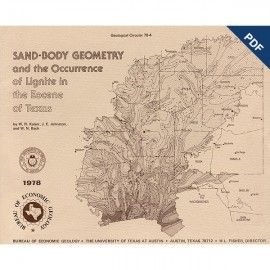Reports of Investigations
-
Books & Reports
- Reports of Investigations
- Guidebooks
- Udden Series
- Geological Circulars
- Down To Earth
- Atlases of Major Oil and Gas Reservoirs
- Texas Memorial Museum Publications
- Environmental Geologic Atlas of the Texas Coastal Zone
- Mineral Resource Circulars
- Other Reports
- Seminars and Workshops
- Handbooks
- Submerged Lands of Texas
- Symposia
- Annual Reports
- Open File Reports
-
Maps & Cross Sections
- Thematic Maps
- Miscellaneous Maps, Charts & Sections
- Geologic Atlas of Texas
- STATEMAP Project Maps
- Geologic Quadrangle Maps
- Cross Sections
- Highway Geology Map
- Energy and Mineral Resource Maps
- Shoreline Change and Other Posters
- Wilcox Group, East Texas, Geological / Hydrological Folios
- Bouguer Gravity Atlas of Texas
- River Basin Regional Studies
- Featured Maps
- Posters
- Teachers & the Public
-
Geological Society Publications
- Gulf Coast Association of Geological Societies
- Alabama Geological Society
- Austin Geological Society
- Corpus Christi Geological Society
- Houston Geological Society
- Lafayette Geological Society
- Mississippi Geological Society
- New Orleans Geological Society
- South Texas Geological Society
- GCS SEPM Publications
- Historic BEG & UT Series

Nomenclature Revision of Basal Cretaceous Rocks between the Colorado and Red Rivers, Texas. Digital Download
RI0058D
A free, digital version of this publication can be found on: Texas ScholarWorks
To purchase a print version (if available): RI0058
RI0058D. Nomenclature Revision of Basal Cretaceous Rocks between the Colorado and Red Rivers, Texas, by W. L. Fisher and P. U. Rodda. 20 p., 8 figs., 1 map, 1966. doi.org/10.23867/RI0058D. Downloadable PDF
To purchase this publication in book format, please order RI0058.
ABSTRACT
Based on need for convenient, small-scale cartographic units, the basal Cretaceous rocks in Texas from Red River to Burnet County and on the Callahan Divide are herein divided into three distinctive lithologic sequences. These are recognized by changes in facies and by the presence or absence of overlying definitive units and include: (1) North-central Texas sequence overlain by the Glen Rose Formation and characterized by siliceous conglomerates and lack of carbonate units (Twin Mountains Formation) (new name); (2) North Texas and West-central Texas sequences extending beyond pinch-out of the Glen Rose Formation with basal and stratigraphically higher clastics included in a single unit (Antlers Formation); (3) Central Texas sequence overlain by Glen Rose Formation but characterized by carbonate units and coarse, locally derived, limestone and dolomite conglomerates (Travis Peak Formation). The outcrop sequence of North-central Texas grades eastward in the subsurface to a basinal sequence overlain by the Glen Rose Formation and divided into (in ascending order) the Hosston, Sligo, Pearsall, and Hensel Formations. The name Trinity is confusing in its various uses and should be reserved for higher rank units, i.e., Group or Division, where such units are judged necessary and are clearly defined in areal scope as well as vertical sequence.
Keywords: nomenclature, Colorado River, Red River, Texas, stratigraphy
Citation
Fisher, W. L., and Rodda, P. U., 1966, Nomenclature Revision of Basal Cretaceous Rocks between the Colorado and Red Rivers, Texas: The University of Texas at Austin, Bureau of Economic Geology, Report of Investigations No. 58, 20 p. doi.org/10.23867/RI0058D.




